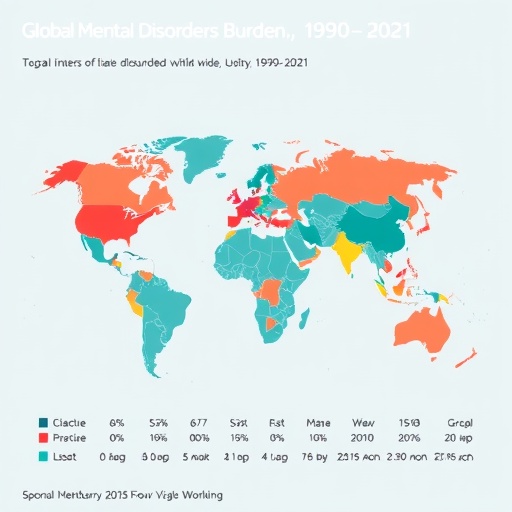In a groundbreaking analysis published in BMC Psychiatry, scientists have unveiled the evolving landscape of mental health disorders across 204 countries and territories over three decades, meticulously chronicling data from 1990 to 2021. This comprehensive study draws from the Global Burden of Disease Study 2021 (GBD 2021) to shed light on the staggering incidence and disability-adjusted life years (DALYs) associated with mental disorders worldwide. The sheer scope of this investigation offers an unparalleled glimpse into the mental health crisis intensifying on a global scale, underscored by socio-demographic variables and the unprecedented challenges posed by the COVID-19 pandemic.
The global tally in 2021 alone revealed an alarming 444 million new cases of mental disorders, coupled with over 155 million DALYs, indicators of the vast human suffering and functional impairments attributable to these conditions. Notably, the study identified a pronounced upward trend in both the age-standardized incidence rate (ASIR) and age-standardized DALY rate (ASR), with increases of approximately 15.2% and 17.3%, respectively, over the three decades reviewed. Such trends not only reflect heightened recognition and diagnosis of mental disorders but also the growing public health impact these diseases exert worldwide.
Regional disparities emerged strongly from the analysis, with Central Sub-Saharan Africa exhibiting the highest ASIR — nearly triple that observed in East Asia, the region with the lowest rates. Contrarily, Australia reported the highest ASR, highlighting significant geographic variability in disease burden and healthcare outcomes. On a national scale, countries such as Greenland, Greece, the United States, and Australia registered the highest DALY rates, indicating concentrated areas where mental health infrastructure and intervention may require urgent reinforcement.
The socio-demographic index (SDI), a composite measure incorporating income, education, and fertility rates, profoundly influenced mental disorder burdens. Interestingly, while all SDI quintiles except East Asia experienced increased incidence rates during the COVID-19 pandemic period (2019–2021), the data underscore the pandemic’s differential impact on mental health globally. These findings provide crucial insight into how social determinants and regional dynamics intersect with disease patterns, emphasizing the need for tailored public health strategies.
Gender-based analysis revealed that females consistently bore a higher burden of mental disorders as measured by age-standardized rates. This disparity illuminates complex socio-cultural, biological, and psychological factors contributing to women’s elevated vulnerability. Understanding these dynamics can help shape gender-sensitive mental health policies and ensure equitable access to care and resources.
Delving deeper into specific mental disorder subtypes, major depressive disorder and anxiety disorders emerged as the leading contributors to the mental health burden, possessing the highest age-standardized rates worldwide. Major depressive disorder, in particular, ranked first in the burden across 13 of 21 global regions, reaffirming its role as a profound public health challenge. Notably, anxiety disorders also exhibited the most significant increase in DALYs over time, highlighting their growing societal impact.
Intriguingly, the overall upward trend in DALYs was not uniform across all mental disorder subtypes. This heterogeneity suggests variations in disease detection, treatment efficacy, and possibly differing etiological factors. These nuances are critical for guiding resource allocation and prioritizing disorder-specific interventions that can more effectively mitigate the global mental health burden.
At the heart of these findings is the recognition that mental disorders represent an escalating global health crisis with widespread implications for societies and healthcare systems. The study’s longitudinal design, encompassing 31 years of data, enables an appreciation not only of current disease magnitude but also of evolving trends, enabling policymakers and healthcare providers to anticipate future challenges with greater precision.
The COVID-19 pandemic’s role as a catalyst exacerbating mental health issues is particularly salient. Social isolation, economic uncertainty, and disruption of health services during this period likely intensified mental health struggles worldwide. The pandemic thus underscores the urgency for integrating mental health support into broader emergency preparedness and response frameworks.
Given these insights, the authors advocate for comprehensive mental health strategies encompassing knowledge dissemination, prevention initiatives, and the development of tailored interventions. Prioritizing high-SDI regions and focusing on vulnerable populations, especially women, are essential steps toward reducing disparities and alleviating the growing burden.
Moreover, the study exemplifies the power of robust epidemiological surveillance and advanced analytic techniques, such as joinpoint regression, in illuminating disease trajectories. These methods offer valuable tools for dynamically monitoring public health trends and informing evidence-based decision-making for mental health.
Ultimately, this extensive evaluation from the GBD 2021 provides a stark reminder of the unmet needs in mental health care and the imperative for global collaboration. Addressing these challenges demands multi-sectoral approaches encompassing policy reform, increased funding, research investment, and destigmatization efforts to foster environments where mental well-being can thrive.
As mental disorders continue to intensify in prevalence and impact, this pivotal research beckons the scientific community, health practitioners, and governments to urgently recalibrate priorities. Only through coordinated action anchored in rigorous data and nuanced understanding can the global burden of mental disorders be effectively tackled in the decades ahead.
Subject of Research: Global burden and trends of mental disorders across 204 countries and territories from 1990 to 2021, including the impact of COVID-19.
Article Title: Global burden of mental disorders in 204 countries and territories, 1990–2021: results from the global burden of disease study 2021
Article References:
Fan, Y., Fan, A., Yang, Z. et al. Global burden of mental disorders in 204 countries and territories, 1990–2021: results from the global burden of disease study 2021. BMC Psychiatry 25, 486 (2025). https://doi.org/10.1186/s12888-025-06932-y
Image Credits: AI Generated




